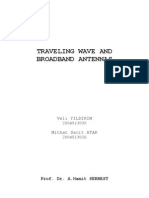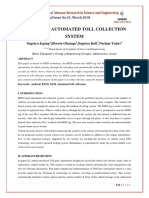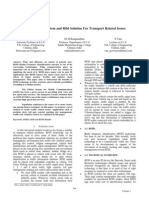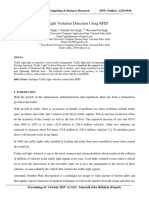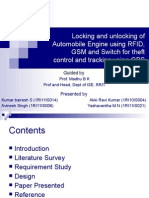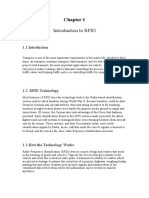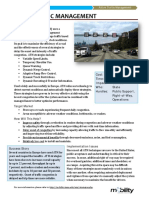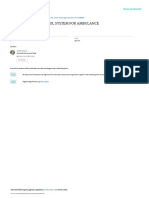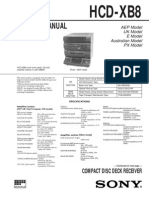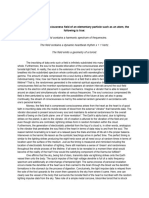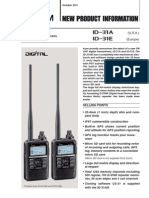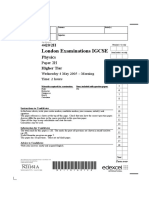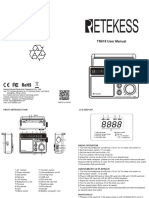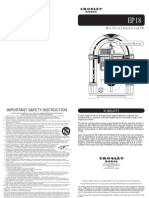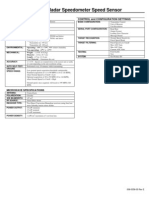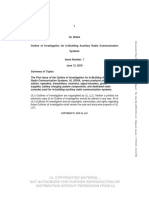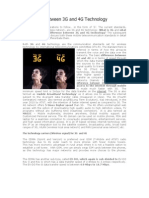Traffic Lane Controller Using Rfid and Iot: Computer Science and Information Technologies
Traffic Lane Controller Using Rfid and Iot: Computer Science and Information Technologies
Uploaded by
Simona NicoletaCopyright:
Available Formats
Traffic Lane Controller Using Rfid and Iot: Computer Science and Information Technologies
Traffic Lane Controller Using Rfid and Iot: Computer Science and Information Technologies
Uploaded by
Simona NicoletaOriginal Title
Copyright
Available Formats
Share this document
Did you find this document useful?
Is this content inappropriate?
Copyright:
Available Formats
Traffic Lane Controller Using Rfid and Iot: Computer Science and Information Technologies
Traffic Lane Controller Using Rfid and Iot: Computer Science and Information Technologies
Uploaded by
Simona NicoletaCopyright:
Available Formats
Computer Science and Information Technologies
Vol. 1, No. 1, May 2020, pp. 13~16
ISSN: 2722-3221, DOI: 10.11591/csit.v1i1.p13-16 13
Traffic lane controller using RFID and IoT
Veera Boopathy E
Department of ECE, Er. Perumal Manimekalai College of Engineering, Hosur, India
Article Info ABSTRACT
Article history: Traffic in urban areas is increasing day by day which leads to most critical
issues of traffic management this paper proposes a smart and fully automatic
Received Aug 12, 2019 traffic control system that will detect and control the congestion in real time,
Revised Dec 23, 2019 detect a stolen vehicle and also passes emergency vehicles smoothly with the
Accepted Jan 10, 2020 use of passive RFID device. This effectively reduces travel delays and
relieves congestion, it is necessary to control lane merge behaviours of
freeway. Depending upon the count of vehicles green passage will be set
Keywords: dynamically and the proposed system provides special privileges for
emergency vehicles like police vehicle, ambulance, VIP vehicles, etc.
GSM
RFID reader
RFID tag
TICS
ZigBee This is an open access article under the CC BY-SA license.
Corresponding Author:
Veera Boopathy.E,
Department of ECE,
Er. Perumal Manimekalai College of Engineering,
Hosur, India.
Email: boopathy.veera@gmail.com
1. INTRODUCTION
RFID tags placed at every 500m on road would be read by the RFID reader on the vehicle, and
transmit the read tag id to the cloud. Traffic light posts are placed at the traffic junction. Traffic light set the
green passageway for specific period of time which is not a complete systematic system as it cannot solve the
traffic problems fully. The proposed system will have RFID readers at the vehicles that will read all the RFID
tags attached on road coming towards the junction. RFID technology consists following components.
a. Radio-frequency-identification (RFID) tag
RFID tag uses small radio frequency identification and tracking purpose and track tags attached to
objects automatically. The tags contain electronically saved information. It contain an integrated circuit and
an antenna, which are used to transmit data to the RFID reader Passive tags gain energy from a nearby RFID
reader's interrogating radio waves. Active tags have their own power source such as a battery and may
operate at hundreds of meters from the RFID reader.
b. RFID reader
The purpose an RFID reader's is to identify RFID tags. A reader contains a Radio Frequency
module, which acts as both a transmitter as well as receiver of radio frequency signals. To generate the
carrier frequency, the transmitter contains of an oscillator. The receiver has a demodulator to extract the
returned data and also for processing it contains an amplifier to strengthen the signal. A microprocessor
forms the control system, memory to filter and store the data. The data is then ready to be sent to the network.
Journal homepage: http://iaesprime.com/index.php/csit
14 ISSN: 2722-3221
RFID technology [1] uses digital data within RFID tag, which is made up of integrated circuits
which contains a small antenna for transferring information to RFID readers. The greater part of RFID tags
encloses as a minimum an integrated circuit for demodulating and modulating RF waves and an antenna.
Frequency ranges differ from low frequencies of 125 to 134 kHz and 140 to 148.5 kHz, and high frequencies
of 850 to 950 MHz and 2.4 to 2.5 GHz. Wavelengths in the 2.4 GHz range.
2. EXISTING SYSTEM
2.1. Camera
There will be four cameras in one intersection for a junction road. A CPU will be connected with
these cameras which will be used for video processing. The RFID will be positioned under the road for
detection of the car. The hardware's used: HD Camera [4], CPU (For video processing), Microprocessor (For
traffic light controlling) and RFID Reader (For vehicle Detection) which will be besides the road. Then using
Frame by frame Real-time video analysis through Developed algorithm, how much cars are present on the
Road can be detected. Depending on the number of Detected vehicles implementation of a serial traffic
Timer system is done. This information will be transmitted to CPU or the central database. According to this
automatic traffic system, the traffic light ON/OFF will depend on the number of Vehicles on the Road. The
CPU will detect each and every car and will Count the vehicle number in the road by using the Developed
algorithm. It will also do the same thing with other side of the road by using another camera.
CPU then compares vehicle number on adjacent roads. The road which has more vehicles will get
the preference and green Light for that road will be set on and red signal will be displayed automatically to
the other road. Traffic lights will be connected to the central system and intelligent System will control the
traffic light system.
2.2. WSN
The work in proposed an approach to integrate Wireless Sensor Network (WSN) in the RFID
Reader to implement Traffic controlling system where motion sensors are used to transmit signal to the RFID
reader to enter in the read Area when it detects the RFID tag and then RFID Reader Reads the contents of
RFID tag and pass this information to Host via IEEE 802.15.4/ZigBee standard, which reduces Cost and time
required by eliminating the wired Installation of cable. Each intersection contains 8 RFID readers.
The road is divided into two separate lanes. Each lane has its RFID Reader to track the vehicles
passing through it. Each Intersection point has its separate database to store the Information regarding the
vehicles that passed from junction. Every vehicle has a RFID enabled device that stores a vehicle
identification number (VIN) [5]. The duty of the smart traffic controller is to compute the time of green
signal specifically basis on the amount of vehicle and also solve the problem of starvation. This is
recommended for object detection and contour tracing. After finding the edges then count objects as defined
by the edges. RFID TAG must be installed in each and every vehicle that is being used.
RFID READER placed at most critical spots on road would be read by the on the vehicle, and
transmit the read tag id to the cloud. The Tag information table in cloud would fetch information regarding
the Locality/Road/Lane [6]. The data base of the vehicle which is maintained by control room.
2.3. GPS system and ZigBee
This proposed system has three parts. First part contains Equipped with an RFID tag and reader at
traffic junction. When it comes in the range of RFID reader, it will send the signal to the RFID reader which
will track how many Vehicles have passed through the junction for a specific Period of time and determine
the traffic congestion volume.
Accordingly, it sets the green passage for that particular path. Second part is for the emergency
vehicle detection and clearance. Here, each emergency vehicle contains ZigBee transmitter and the ZigBee
receiver will be present at the traffic junction. The buzzer will be turned ON when the vehicle is used for
emergency. This will send the signal through the ZigBee transmitter to the Receiver. It will turn the traffic
light to change to green. Once the ambulance passes through junction, the receiver no longer receives the
ZigBee signal and the traffic light is switched to red. RFID and GPS based automatic traffic clearance system
for ambulance.
The motivation of this job is to decrease the delay for the ambulance to reach to the hospital by
automatically clearing the traffic lane, before it reaches the traffic signal. The third part is for detection of
stolen vehicle. Here, when the RFID reader reads the RFID tag, it compares it to the registered stolen RFIDs
and GPS are positioned together with the stolen automobile recognition module [2], so that the exact location
of stolen vehicle is known. But when an equal is create, it transmits SMS toward control room of police, so
that the vehicle is made to stop in the traffic junction and local police can take appropriate action.
Comput. Sci. Inf. Technol., Vol. 5, No. 1, May 2020: 13-16
Comput. Sci. Inf. Technol. 15
3. PROPOSED SYSTEM
In this paper we propose to install an intelligent tracking device on every vehicle. The reader would
provide following features for controlling the Traffic in Highways,
− Ensures the Vehicles running on Highways follow lane discipline
− Identifies and Reports cause for Congestion in a fast track road.
− Enables automated deduction of violations and charges penalties or license cancellation etc.
− Helps in Reducing Bribery in the Traffic control mechanisms in avoiding Violations.
− Increases consciousness in vehicle operators.
Creates ways to new Traffic prediction to reduce the influence of lane closure, this paper designs the
control flow of Intelligent Lane Merge Control System (ILMCS) [3] with ITS techniques, and constructs
Traffic Information Collection System, Traffic Information Process and Decision System and Traffic
Information Release System of ILMCS.
Figure 1. Design of proposed RFID tag system
The system identifies traffic states by analyzing real-time data collected by traffic detectors and then
adopts adaptive lane merge control strategies by analyzing the extent of traffic congestion.
At last, the paper evaluates ILMCS performances by simulation. The results show the performances
of ILMCS exceed conventional merge controls, dynamic early merge control and dynamic late merge
control, especially in improving freeway work zones safety and capacity.
The main components of ILMCS are Traffic Information Collection System (TICS), Traffic
Information Process and Decision System (TIPDS) and Traffic Information Release System (TIRS). TICS is
the basis of ILMCS, using traffic detectors to collect data and transfer to TIPDS by communication network.
TIPDS is the core component of ILMCS to decide which control strategy should be adopted. TIRS releases
control strategy information to travelers by using a series of VMS, then to realize dynamic control of the lane
merge. Figure 1 shows the TICS, TIPDS and TIRS components and data flow.
Traffic state is detected by traffic volume, velocity and occupancy data. ILMCS triggers DEM when
traffic volume is low and the system controls the first piece of VMS upstream to show “Left (or Right) Lane
Do Not Pass/ When Flashing”. With the increasing of traffic volume, the upper VMS are triggered in
sequences, until the final piece of VMS on upstream. If traffic volume continues to increase, when the queue
diffuses to upstream of WZ and ILMCS transfers to DLM, where all VMS show the message of “Use Both
Lanes to Merge Point/ When Flashing”. With the real-time change of traffic states, the control strategy of
ILMCS also changes adaptively.
Traffic state is detected by comparing traffic data collected from TICS with the decision thresholds
and the detection algorithms. Some traffic detectors are installed on VMS to monitor traffic density and
congestion. When stopped vehicles are detected in the open lane next to a sign, a signal is transmitted to turn
on the flashing strobes on the next sign upstream while automobiles are running once more, the strobes will
shut off. In this way, the length of the no-passing zone is adapted to the length of congestion at any moment;
thereby it can increase the capacity.
Finally the GSM module number is interfaced with IOT cloud which manage the database
of vehicles and these are accessed by control room TICS act as IOT platform that collect the information
and by using intelligence if any vehicle cross the speed limit of the Lane then vehicle details
is noted in control room.
Traffic lane controller using RFID and IoT (Veera Boopathy E)
16 ISSN: 2722-3221
4. CONCLUSION
The previous systems work efficiently to manage to manage the traffic but does not provide quality
of service for additional emergency and stolen vehicles and use Hardware like ZigBee etc. and complicate
the system. The Proposed system works effectively and with higher accuracy in managing the traffic at
junction with different priorities at different time.
REFERENCES
[1] Andrew G. Beacher, Mechael D. Fontaine and Nicholas J. Garber, Evaluation of the late merge work zone traffic
control strategy, Virginia Transportation Research Council, Final Report, 2004.
[2] Andrzej P. Tarko, Daniel Shamo and Jason Wasson, Indiana lane merge system for work zones on rural freeways,
Journal of Transportation Engineering, 1999, 125(5):415-420.
[3] Tapan Datta, Kerrie Schattler, Puskar Kar and Arpita Guha, Development and evaluation of an advanced dynamic
lane merge traffic control system for 3 to 2 lane transition areas in work zones, Michigan Department of
Transportation, Research Report RC-1451, 2004.
[4] Eric Meyer, Construction area late merges (CALM) system, FHWA Pooled Fund Study, 2004.
[5] Kyeong-Pyo Kang, Gang-Len Chang and Jawad Paracha, Dynamic late merge control at highway work zones:
evaluation, observations, and suggestions, TRB 2006 Annual Meeting CD-ROM, 2006, 1-28.
[6] Patrick T. McCoy and Geza Pesti, Dynamic late merge control concept for work zones on rural freeways, Available:
http://ops.fhwa.dot.gov/wz/workshops/accessible/McCoy.htm,US Department of Transportation FHWA, 2006.
Comput. Sci. Inf. Technol., Vol. 5, No. 1, May 2020: 13-16
You might also like
- Broadband Antennas and Traveling WaveDocument40 pagesBroadband Antennas and Traveling WaveVeli67% (3)
- Advanced Tracking System With Automated Toll: Pritam Mhatre, Parag Ippar, Vinod Hingane, Yuvraj Sase, Sukhadev KambleDocument3 pagesAdvanced Tracking System With Automated Toll: Pritam Mhatre, Parag Ippar, Vinod Hingane, Yuvraj Sase, Sukhadev KambleInternational Journal of computational Engineering research (IJCER)No ratings yet
- Intelligent Transportation System Using RFID To Reduce Congestion Ambulance Priority and Stolen Vehicle TrackingDocument4 pagesIntelligent Transportation System Using RFID To Reduce Congestion Ambulance Priority and Stolen Vehicle TrackingMayur ShimpiNo ratings yet
- Electronic Toll Collection SystemDocument4 pagesElectronic Toll Collection SystemvishnuNo ratings yet
- Rfid Based Vehicle Tracking System Circuit DiagramDocument4 pagesRfid Based Vehicle Tracking System Circuit DiagramAkhilaNo ratings yet
- Application of Rfid Technology and The Maximum Spanning Tree Algorithm For Solving Vehicle Emissions in Cities On Internet of Things AimDocument6 pagesApplication of Rfid Technology and The Maximum Spanning Tree Algorithm For Solving Vehicle Emissions in Cities On Internet of Things AimRajreddyNo ratings yet
- JETIR2301580Document4 pagesJETIR2301580Subash SubashanNo ratings yet
- Automated Toll Collection System Based On RFID SensorDocument16 pagesAutomated Toll Collection System Based On RFID SensorAnkit SinghNo ratings yet
- The IOT Based Automatic Toll Gate System Using Raspberry PiDocument8 pagesThe IOT Based Automatic Toll Gate System Using Raspberry PiShubham BhardwajNo ratings yet
- 13 PaperDocument3 pages13 PaperI DKNo ratings yet
- A Smart Way of Emergency Vehicle Tracking SystemDocument6 pagesA Smart Way of Emergency Vehicle Tracking SystemCoding HashtagNo ratings yet
- Rash Drivingppt (2305843009213820123)Document11 pagesRash Drivingppt (2305843009213820123)Timmisetty avinashNo ratings yet
- 09-Installation and Evaluation of RFID Readers On Moving VehiclesDocument10 pages09-Installation and Evaluation of RFID Readers On Moving VehiclesLuan CostaNo ratings yet
- Design & Development of An Autonomic Integrated Car Parking SystemDocument4 pagesDesign & Development of An Autonomic Integrated Car Parking Systemعمر الفاضل ود ستوناNo ratings yet
- Automated Tollplaza System Using RfidDocument6 pagesAutomated Tollplaza System Using RfiddamodharNo ratings yet
- Abstract:: Unauthorized Vehicle Detection in BRTDocument5 pagesAbstract:: Unauthorized Vehicle Detection in BRTrock starNo ratings yet
- 9.CHAPTER 1tollpaymentDocument4 pages9.CHAPTER 1tollpaymentphyumoethar22No ratings yet
- Worla 1526041099 - BVNC-37 PDFDocument4 pagesWorla 1526041099 - BVNC-37 PDFNana JuniorNo ratings yet
- Electronics and Communication EngineeringDocument12 pagesElectronics and Communication Engineeringgokul_rajNo ratings yet
- 14 CHAPTER6tolluseDocument3 pages14 CHAPTER6tollusephyumoethar22No ratings yet
- Automated Unauthorized Parking DetectorDocument4 pagesAutomated Unauthorized Parking DetectorRaghavendra TalekarNo ratings yet
- Design and Implementation of Electronic Tollgate Collection SystemDocument4 pagesDesign and Implementation of Electronic Tollgate Collection SystemseventhsensegroupNo ratings yet
- Development of User Identification Code of A Car SynopsisDocument10 pagesDevelopment of User Identification Code of A Car Synopsismehak90No ratings yet
- Traffic Violation Detection System Based On RFIDDocument5 pagesTraffic Violation Detection System Based On RFIDInternational Journal of Science and Engineering InvestigationsNo ratings yet
- Iot-Based Monitoring System: Car'S ParkingDocument11 pagesIot-Based Monitoring System: Car'S ParkingMarta Marizza DespotovicNo ratings yet
- FPGA Based Real Time Implementation of Modified Tollgate SystemDocument5 pagesFPGA Based Real Time Implementation of Modified Tollgate SystemseventhsensegroupNo ratings yet
- RFID-Based Automatic Vehicle Parking SystemDocument4 pagesRFID-Based Automatic Vehicle Parking SystemFaraz AhmedNo ratings yet
- An Embedded System and RFID Solution For Transport Related IssuesDocument5 pagesAn Embedded System and RFID Solution For Transport Related IssuesKethavath Sakrunaik KNo ratings yet
- Design of Smart Parking Technologies and Vehicle Theft Detection Using IOTDocument6 pagesDesign of Smart Parking Technologies and Vehicle Theft Detection Using IOTInternational Journal of Innovative Science and Research TechnologyNo ratings yet
- Design and Development of RFIDBasedautomatedcarparkingsystemDocument4 pagesDesign and Development of RFIDBasedautomatedcarparkingsystemAvishkar KaduNo ratings yet
- (IJCST-V4I1P27) : Snehal Bankar, Mitali Dhaigude, Sonali Gajendragadakar, Supriya GavliDocument5 pages(IJCST-V4I1P27) : Snehal Bankar, Mitali Dhaigude, Sonali Gajendragadakar, Supriya GavliEighthSenseGroupNo ratings yet
- An Embedded System and Rfid Solution For Transport Related IssuesDocument5 pagesAn Embedded System and Rfid Solution For Transport Related IssuesIliyaz MohammedNo ratings yet
- RFID-based Parking Management SystemDocument4 pagesRFID-based Parking Management Systemakashlogic100% (1)
- Literature Survey (RFID and Android Based Smart Ticketing and Destination Announcement System)Document3 pagesLiterature Survey (RFID and Android Based Smart Ticketing and Destination Announcement System)ram raneNo ratings yet
- Intelligent Parking Management System Using RFIDDocument9 pagesIntelligent Parking Management System Using RFIDKhaoula HassouneNo ratings yet
- Red Light DetectionDocument9 pagesRed Light DetectionBilal AhmedNo ratings yet
- Design & Analysis of Vehicle Speed Control Unit Using RF TechnologyDocument7 pagesDesign & Analysis of Vehicle Speed Control Unit Using RF TechnologyVrushabh Madanlal JainNo ratings yet
- Vehicle Speed Control in Restricted AreaDocument37 pagesVehicle Speed Control in Restricted AreaTamil Thalapathi VananNo ratings yet
- Automated Unauthorized Parking Detector With Smart Vehicle ParkingDocument5 pagesAutomated Unauthorized Parking Detector With Smart Vehicle ParkingToheebdareNo ratings yet
- 1I43 IJSRMS0405740 v4 I7 pp124 127Document4 pages1I43 IJSRMS0405740 v4 I7 pp124 127aaronedwardsantosbroasNo ratings yet
- Smart Parking System Using RFIDDocument4 pagesSmart Parking System Using RFIDhirNo ratings yet
- IOT Based Traffic System by Vehicle Number Plate Identification Traffic MonitoringDocument3 pagesIOT Based Traffic System by Vehicle Number Plate Identification Traffic MonitoringmohammedjafferdxmjNo ratings yet
- Design and Implementation of Low Cost Automatic Toll Collection System Using RFIDDocument6 pagesDesign and Implementation of Low Cost Automatic Toll Collection System Using RFIDGRD JournalsNo ratings yet
- Smart Parking Applications Using RfidDocument1 pageSmart Parking Applications Using RfidBrightchip TechnologiesNo ratings yet
- Irjet V5i3694 PDFDocument4 pagesIrjet V5i3694 PDFarshia tabassumNo ratings yet
- F6 Hasan - RFID TicketingDocument5 pagesF6 Hasan - RFID TicketingSathyanarayana RaoNo ratings yet
- Locking and Unlocking of Automobile Engine Using RFID1Document19 pagesLocking and Unlocking of Automobile Engine Using RFID1Ravi AkkiNo ratings yet
- Chapter2tollDocument9 pagesChapter2tollphyumoethar22No ratings yet
- Bus Management System Using RFID in WSN: Ben Ammar Hatem, Faculty of Engineering, University of Moncton, NBDocument8 pagesBus Management System Using RFID in WSN: Ben Ammar Hatem, Faculty of Engineering, University of Moncton, NBdivyasathyakayalNo ratings yet
- Design of Auto-Guard System Based On RFID and NetworkDocument18 pagesDesign of Auto-Guard System Based On RFID and NetworksyedaNo ratings yet
- Chapter 1Document3 pagesChapter 1Eng Mohammad AfanehNo ratings yet
- The Smart Parking Management SystemDocument12 pagesThe Smart Parking Management SystemIan GakuhiNo ratings yet
- Proposed Intelligent Traffic Violation Detection System Using RfidDocument4 pagesProposed Intelligent Traffic Violation Detection System Using RfidtelemetryappsNo ratings yet
- Tolling StrategiesDocument3 pagesTolling Strategiessolitary_monk100% (1)
- Ijret - Design of Intelligent Transport Related Issue System Based On Arm7Document5 pagesIjret - Design of Intelligent Transport Related Issue System Based On Arm7International Journal of Research in Engineering and TechnologyNo ratings yet
- Automatic Movable Smart Road Dividers - IOT Based Solution To Traffic Congestion ProblemsDocument6 pagesAutomatic Movable Smart Road Dividers - IOT Based Solution To Traffic Congestion ProblemsInternational Journal of Innovative Science and Research Technology0% (1)
- Arduino Based RFID Controlled Automatic E-TOLL Collection SystemDocument3 pagesArduino Based RFID Controlled Automatic E-TOLL Collection SystemSalmaAliNo ratings yet
- Vehicle Tracking and Ticketing System (VTTS) Using RFID (Complete Softcopy)Document56 pagesVehicle Tracking and Ticketing System (VTTS) Using RFID (Complete Softcopy)Hari Krishnan MA100% (129)
- A Review On Smart Parking Systems: © FEB 2021 - IRE Journals - Volume 4 Issue 8 - ISSN: 2456-8880Document8 pagesA Review On Smart Parking Systems: © FEB 2021 - IRE Journals - Volume 4 Issue 8 - ISSN: 2456-8880Raghav SharmaNo ratings yet
- Automatic Number Plate Recognition: Fundamentals and ApplicationsFrom EverandAutomatic Number Plate Recognition: Fundamentals and ApplicationsNo ratings yet
- Automatic Number Plate Recognition: Unlocking the Potential of Computer Vision TechnologyFrom EverandAutomatic Number Plate Recognition: Unlocking the Potential of Computer Vision TechnologyNo ratings yet
- Intelligent Transport Systems and Effects On Road Traffic Accidents: State of The ArtDocument9 pagesIntelligent Transport Systems and Effects On Road Traffic Accidents: State of The ArtSimona NicoletaNo ratings yet
- Active Traffic Management 1 PGDocument1 pageActive Traffic Management 1 PGSimona NicoletaNo ratings yet
- Optimal System Design For Weigh-In-Motion Measurements Using In-Pavement Strain SensorsDocument8 pagesOptimal System Design For Weigh-In-Motion Measurements Using In-Pavement Strain SensorsSimona NicoletaNo ratings yet
- Dot 37919 DS1 PDFDocument124 pagesDot 37919 DS1 PDFSimona NicoletaNo ratings yet
- Smart Traffic Control System For Ambulance: September 2016Document5 pagesSmart Traffic Control System For Ambulance: September 2016Simona NicoletaNo ratings yet
- An Intelligent Road Traffic Management System Based On A Human Community Genetic AlgorithmDocument7 pagesAn Intelligent Road Traffic Management System Based On A Human Community Genetic AlgorithmSimona NicoletaNo ratings yet
- 10A 1-30V Variable Power Supply With LM317Document4 pages10A 1-30V Variable Power Supply With LM317Robin GardenerNo ratings yet
- Igcse e Waves With MSCDocument82 pagesIgcse e Waves With MSCaliNo ratings yet
- MI-AT10M-Motorized Antenna Trainer With 10 AntennasDocument2 pagesMI-AT10M-Motorized Antenna Trainer With 10 AntennasMine InstrumentsNo ratings yet
- Manual de Servicio Sony - hcd-xb8Document82 pagesManual de Servicio Sony - hcd-xb8Martín SayagoNo ratings yet
- Consciousness of The Soul FieldDocument7 pagesConsciousness of The Soul FieldRyan RosenquistNo ratings yet
- Id-31a Id-31e: (U.S.A.) (Europe)Document5 pagesId-31a Id-31e: (U.S.A.) (Europe)Giannis VaitsisNo ratings yet
- Doppler QuestionDocument3 pagesDoppler QuestionJohnNo ratings yet
- SSB Single-Sideband ModulationDocument6 pagesSSB Single-Sideband ModulationfiraszekiNo ratings yet
- 2005 June Physics 2h PDFDocument24 pages2005 June Physics 2h PDFTatenda ChimwandaNo ratings yet
- Onkyo tx-ds787 Manual InglêsDocument76 pagesOnkyo tx-ds787 Manual InglêsRodrigoNo ratings yet
- WS3967-P 217Document2 pagesWS3967-P 217ghalibjanjuaNo ratings yet
- Ultralite 380 480 Manual 1Document26 pagesUltralite 380 480 Manual 1Daz EastNo ratings yet
- Konsep Kanal Fisik Dan Logik Pada GSM PDFDocument34 pagesKonsep Kanal Fisik Dan Logik Pada GSM PDFWaluyNo ratings yet
- Fdma in Satellite Communication PDFDocument2 pagesFdma in Satellite Communication PDFMarianito0% (1)
- Wideband Dual-Circularly Polarized Antennas Using Aperture-Coupled Stacked Patches and Single-Section Hybrid CouplerDocument9 pagesWideband Dual-Circularly Polarized Antennas Using Aperture-Coupled Stacked Patches and Single-Section Hybrid Couplerdtvt2006No ratings yet
- Manual Radio (TR618-English)Document5 pagesManual Radio (TR618-English)gustavoasfonsecaNo ratings yet
- Pcs Module 5 NotesDocument47 pagesPcs Module 5 NotesYogeshwar SNo ratings yet
- E22-400M33S Usermanual EN v1.3Document15 pagesE22-400M33S Usermanual EN v1.3tbws666No ratings yet
- Antenna Height Vs Take Off AnglesDocument7 pagesAntenna Height Vs Take Off AnglespinocleNo ratings yet
- Wireless Cellular and LTE 4G Broadband 1Document76 pagesWireless Cellular and LTE 4G Broadband 1PRANEETH DpvNo ratings yet
- User Equipment (UE) Radio Transmission and ReceptionDocument51 pagesUser Equipment (UE) Radio Transmission and ReceptionJúlio SantosNo ratings yet
- Elvis Presley Jukebox With CD: Instruction ManualDocument6 pagesElvis Presley Jukebox With CD: Instruction ManualPayphone.comNo ratings yet
- Speedometer Speed Sensor SpecificationDocument1 pageSpeedometer Speed Sensor SpecificationEng We'am MasriNo ratings yet
- Biochip TechnologyDocument20 pagesBiochip Technologysanagunda45No ratings yet
- Ul 2524a FullDocument96 pagesUl 2524a FullRobert LegaultNo ratings yet
- Qs in Interview of RTR ADocument3 pagesQs in Interview of RTR ANirja oza100% (1)
- Power Allocation of Cooperative Amplify-And-Forward Communications With Multiple RelaysDocument5 pagesPower Allocation of Cooperative Amplify-And-Forward Communications With Multiple RelaysGagandeep KaurNo ratings yet
- Difference Between 3G and 4G Technology PDFDocument2 pagesDifference Between 3G and 4G Technology PDFsatyapati99No ratings yet
- Isdbt DigitDocument8 pagesIsdbt DigitSauradeep DebnathNo ratings yet
